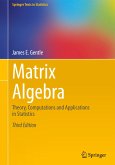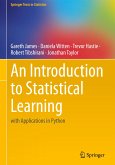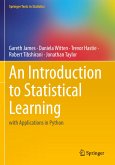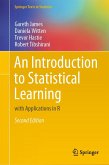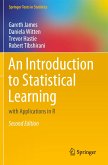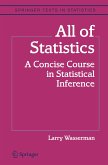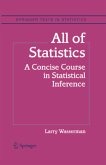This textbook for graduate and advanced undergraduate students presents the theory of matrix algebra for statistical applications, explores various types of matrices encountered in statistics, and covers numerical linear algebra. Matrix algebra is one of the most important areas of mathematics in data science and in statistical theory, and the second edition of this very popular textbook provides essential updates and comprehensive coverage on critical topics in mathematics in data science and in statistical theory.
Part I offers a self-contained description of relevant aspects of the theory of matrix algebra for applications in statistics. It begins with fundamental concepts of vectors and vector spaces; covers basic algebraic properties of matrices and analytic properties of vectors and matrices in multivariate calculus; and concludes with a discussion on operations on matrices in solutions of linear systems and in eigenanalysis. Part II considers various types of matricesencountered in statistics, such as projection matrices and positive definite matrices, and describes special properties of those matrices; and describes various applications of matrix theory in statistics, including linear models, multivariate analysis, and stochastic processes. Part III covers numerical linear algebra-one of the most important subjects in the field of statistical computing. It begins with a discussion of the basics of numerical computations and goes on to describe accurate and efficient algorithms for factoring matrices, how to solve linear systems of equations, and the extraction of eigenvalues and eigenvectors.
Although the book is not tied to any particular software system, it describes and gives examples of the use of modern computer software for numerical linear algebra. This part is essentially self-contained, although it assumes some ability to program in Fortran or C and/or the ability to use R or Matlab.
The first two parts of the text are ideal for a course in matrix algebra for statistics students or as a supplementary text for various courses in linear models or multivariate statistics. The third part is ideal for use as a text for a course in statistical computing or as a supplementary text for various courses that emphasize computations.
New to this edition
- 100 pages of additional material
- 30 more exercises-186 exercises overall
- Added discussion of vectors and matrices with complex elements
- Additional material on statistical applications
- Extensive and reader-friendly cross references and index
Part I offers a self-contained description of relevant aspects of the theory of matrix algebra for applications in statistics. It begins with fundamental concepts of vectors and vector spaces; covers basic algebraic properties of matrices and analytic properties of vectors and matrices in multivariate calculus; and concludes with a discussion on operations on matrices in solutions of linear systems and in eigenanalysis. Part II considers various types of matricesencountered in statistics, such as projection matrices and positive definite matrices, and describes special properties of those matrices; and describes various applications of matrix theory in statistics, including linear models, multivariate analysis, and stochastic processes. Part III covers numerical linear algebra-one of the most important subjects in the field of statistical computing. It begins with a discussion of the basics of numerical computations and goes on to describe accurate and efficient algorithms for factoring matrices, how to solve linear systems of equations, and the extraction of eigenvalues and eigenvectors.
Although the book is not tied to any particular software system, it describes and gives examples of the use of modern computer software for numerical linear algebra. This part is essentially self-contained, although it assumes some ability to program in Fortran or C and/or the ability to use R or Matlab.
The first two parts of the text are ideal for a course in matrix algebra for statistics students or as a supplementary text for various courses in linear models or multivariate statistics. The third part is ideal for use as a text for a course in statistical computing or as a supplementary text for various courses that emphasize computations.
New to this edition
- 100 pages of additional material
- 30 more exercises-186 exercises overall
- Added discussion of vectors and matrices with complex elements
- Additional material on statistical applications
- Extensive and reader-friendly cross references and index
"Gentle has put in a lot of time and effort to writing this book with careful attention to details. ... it is all needed to make sure the student has a firm and solid understanding of matrix algebra on the graduate level. I would recommend this book for all those who teach graduate level matrix algebra or ... to those undergraduate students who wish to have an independent study." (Peter Olszewski, MAA Reviews, January, 2018)
"Beautifully written, easy to read, with a well subindexed index of 16 pages and a bibliography of 13 that includes most modern and relevant textbooks and articles in the area of matrix theory and computations, as well as for statistics and big data computations." (Frank Uhlig, zbMATH 1386.15002, 2018)
"This very reader-friendly written volume presents an opportunity to graduate students and researchers to enjoy reading on the classical matrix analysis in its modern applications to statistics and to implement thesemethods in practical problem solving." (Stan Lipovetsky, Technometrics, Vol. 60 (2), 2018)
"Beautifully written, easy to read, with a well subindexed index of 16 pages and a bibliography of 13 that includes most modern and relevant textbooks and articles in the area of matrix theory and computations, as well as for statistics and big data computations." (Frank Uhlig, zbMATH 1386.15002, 2018)
"This very reader-friendly written volume presents an opportunity to graduate students and researchers to enjoy reading on the classical matrix analysis in its modern applications to statistics and to implement thesemethods in practical problem solving." (Stan Lipovetsky, Technometrics, Vol. 60 (2), 2018)


